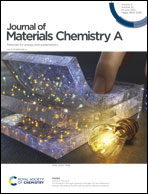Recyclable and CO2-retardant Zn–air batteries based on CO2-decorated highly conductive cellulose electrolytes†
Abstract
The ever-increasing fossil fuel consumption and portable electronic device proliferation have caused numerous environmental challenges in terms of producing massive carbon dioxide (CO2) emissions and end-of-life wastes. Incorporating naturally abundant resources into the recyclable and renewable battery components at the design stage has, therefore, become essential. Cellulose (CC) is an attractive raw material for eco-friendly solid/gel polymer electrolytes. However, they suffer from unsatisfactory ionic conductivity due to the narrow spacing between the molecular chains originating from the strong inherent inter- and intra-molecular hydrogen bonds. Herein, we propose a strategy to achieve highly conductive cellulose by bedecking the CC with CO2via its ionization (CC-CO2), which breaks the inherent inter- and intra-molecular hydrogen bonds. Upon being employed as quasi-solid-electrolytes for Zn–air batteries (ZABs), the CO2-decorated CC with substantially enhanced conductivity can effectively impede the CO2 poisoning of the electrolyte and Zn dendrite formation, endowing the fabricated ZABs with promoted electrochemical performance and stability even in a CO2-rich atmosphere. The spent CC-CO2 and all chemicals used for the ionization can be facilely and efficiently recycled. Moreover, the CC-CO2 can be degraded to CO2 and glucose on demand. The strategy here sheds light on integrating CO2 utilization with bio-derived materials for renewable energy storage systems to meet sustainability targets.



 Please wait while we load your content...
Please wait while we load your content...